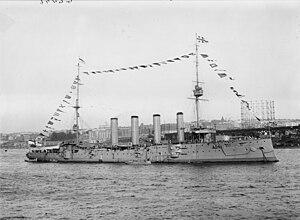 Drake at anchor in New York Harbor in 1909
| |
| History | |
|---|---|
| Name | HMS Drake |
| Namesake | Sir Francis Drake |
| Builder | Pembroke Dock |
| Cost | approx. £800 000 |
| Laid down | 24 April 1899 |
| Launched | 5 March 1901 |
| Christened | Mrs. Lort Phillips |
| Completed | 9 January 1903 |
| Commissioned | 13 January 1903 |
| Fate | Sunk by U-79, 2 October 1917 |
| General characteristics | |
| Class and type | Drake-class armoured cruiser |
| Displacement | 14,150 long tons (14,380 t) (normal) |
| Length | 533 ft 6 in (162.6 m) (o/a) |
| Beam | 71 ft 4 in (21.7 m) |
| Draught | 26 ft (7.9 m) |
| Installed power |
|
| Propulsion |
|
| Speed | 23 knots (43 km/h; 26 mph) |
| Complement | 900 |
| Armament |
|
| Armour | |
HMS Drake was the lead ship of her class of armoured cruisers built for the Royal Navy around 1900. She was assigned to several different cruiser squadrons in home waters upon completion, sometimes as flagship, until 1911 when she became the flagship of the Australia Station. Upon her return home, she was assigned to the 6th Cruiser Squadron of the 2nd Fleet and became the squadron's flagship when the fleet was incorporated into the Grand Fleet upon the outbreak of the First World War.
She remained with the Grand Fleet until refitted in late 1915, when she was transferred to the North America and West Indies Station for convoy escort duties. In 1916 she participated in the unsuccessful search for the German commerce raider SMS Möwe. In late 1917 Drake was torpedoed by a German submarine off Northern Ireland and sank in shallow water with the loss of eighteen lives near Rathlin Island. The wreck was partly salvaged, beginning in 1920; a fishing trawler collided with the remainder of the wreck in 1962 and sank the next day. The wrecks of the two ships were demolished during the 1970s, but their remnants remain a popular dive site. Since June 2017, Drake's wreck has been a scheduled historic monument.
Cite error: There are <ref group=Note> tags on this page, but the references will not show without a {{reflist|group=Note}} template (see the help page).